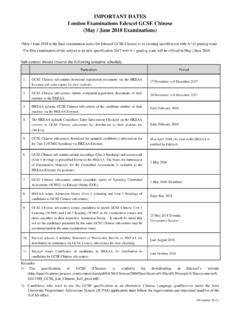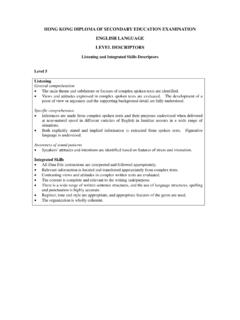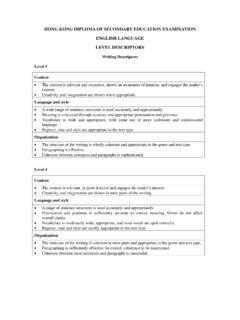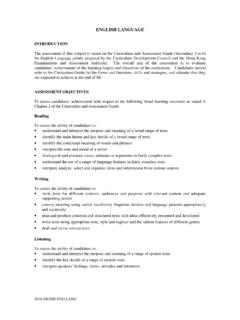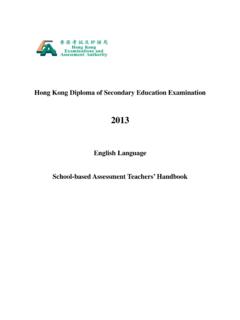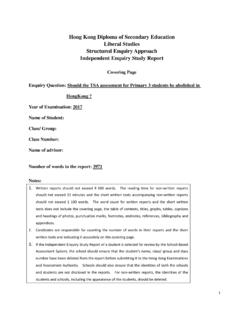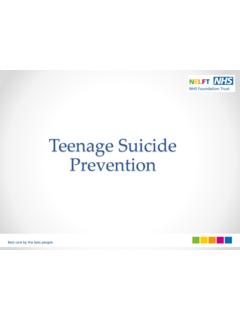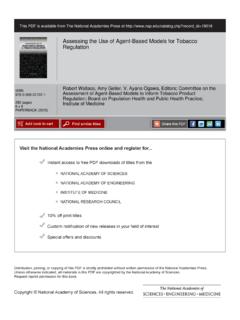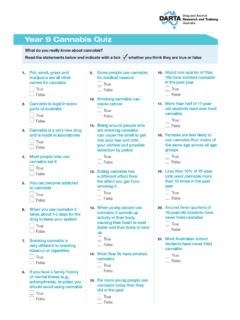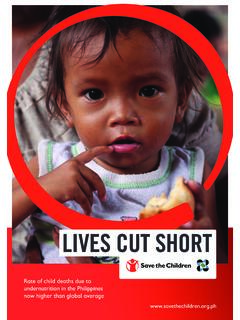Transcription of LIBERAL STUDIES INDEPENDENT ENQUIRY STUDY …
1 LIBERAL STUDIES INDEPENDENT ENQUIRY STUDY report Title: teenage Suicide in Hong Kong and Ways for Prevention Acknowledgement I would like to thank the following people for their generous help and guidance. Without them the completion of this project would be impossible. My Teachers I would like to thank them for their patience, guidance and the large amount of time spent to guide me on this project. Respondents of the Questionnaire I would like to thank them for their patience in completing the questionnaires. My Interviewees I am grateful for the valuable information they gave during the interviews. The scope is much more complete with their help.
2 My friends I would like to thank them for distributing the questionnaires. 2 Table of Contents 1. Introduction 2. Research Objectives 3. Research Methodology 4. Literary review 5. Findings and Analysis Causes for teenagers to attempt suicide and self-harm Methods for prevention of teenage suicide and self-harm 6. Conclusion 7. Reflection 8. Bibliography p. 4 p. 5 p. 7 pp. 8-13 p. 18 p. 19 p. 20 3 1.
3 Introduction It has come to my awareness that the suicide and self-harm rates of teenagers have been rising in the recent decade. From time to time I see on the news that teenagers try to kill themselves because of various reasons. Comparing to 2005, in 2007 the percentage for teenagers to commit suicide has risen to 74%, rising from 19 people to 33 people1. Also, in 2009, compared to 2008, the percentage of death from suicide among teenagers increased by 22%.2 This figure only includes the deaths from successful suicide attempts. Behind this figure there are many unsuccessful attempts that may sadly become successful someday. As suicide and self-harm are both acts of self-destruction, and severe self-harm, which is suicide, will lead to death, therefore in my questionnaire I have included questions for both self-harm and suicide. Suicide and self-harming are taboo topics that are not often brought up by society.
4 Some people avoid talking about them because they are negative and some avoid this because they do not want to share their experience, fearing that others may look down upon them. Therefore I would like to find out the true causes for these acts and to see what can be done against teenage suicide and self-harm by giving out a questionnaire where respondents are anonymous so that their privacy and thoughts can be protected. 17 4 % , W e n W e i P o , 8th July, 2007. 2 2 2 % , Ming Pao News, 28th December, 2009. 4 2. Research Objectives The objectives of this project are - to find out the causes for teenage suicides and self-harm - to find out what people can do to prevent teenagers self-destruction - to find out what teenagers can do to prevent themselves from self-destructing - to find out if there are any relationships between attempting suicide and self-harming - to prove the expected outcome that emotional problems are important factors in causing teenage suicide 5
5 3. Research Methodology Questionnaire The target interviewees are teenagers ranging from 13 to 19 years old. There are 60 respondents for the questionnaire. The questionnaire is designed in the form of multiple-choice / ranking questions to find out what teenagers think the causes for attempting suicide and self-harm are, and what measures they think are suitable for people who want to harm or even kill themselves. The questionnaire has 4 parts. Part 1 asks for the information of the interviewees, part 2 asks for the general opinion on the causes for attempting suicide and self-harm. Part 3 are for respondents who have been through or have seen people going through self-destruction and part 4 asks for the general opinion of ways to prevent self-destruction. Interviews The data collection process also includes two interviews. Interviewee 1 is a female student who first thought about suicide when she was 8 and put the thoughts into action for a few times.
6 Now she has overcome the urge to kill herself and leads a normal life. Interviewee 2 is a female student who first thought about attempting suicide and harming herself in and has not overcome the crisis yet. To ensure that questions asked are suitable for the interviewees, they have to complete the questionnaire first. Limitations The length of the questionnaire might decrease the interest of some respondents from finishing the questionnaire. However this is necessary because detailed questions are needed to produce comprehensive findings. Also, since only 60 responses were collected, the number of samples may not be large enough to make the result representative of all Hong Kong teenagers. Moreover, the teenagers may not understand themselves well enough to tell the true factors that cause them to suicide. 6 4.
7 Literary Review The article Prevention of Suicide: Aspirations and Evidence by David Gunnel and Stephen Frankel studied prevention methods for suicide and briefly discussed its nature. It studied the population as a whole instead of only teenagers, including ways for preventing suicide carried out by the government and by individual institutions. Thus it has a broader scope than this project, which focuses on teenagers only, due to the limitations of data collection. The article is useful for this project because it provides reliable background information for the findings in the survey. The article stated that it is difficult to prevent suicide definitely because no single, readily identifiable, high risk population that constitutes a sizeable proportion of overall suicides and yet represents a small, easily targeted group. It is difficult to always target the potential suicidal population in time and carry out specific measures to prevent them from doing so.
8 The measures found to be useful are those that increase the difficulty of carrying out suicide. For example in Australia, legislation to restrict the selling of sleeping pills had a short term effect on decreasing number of suicides. The method of improving car exhaust designs to prevent a person from killing oneself with toxic exhaust fumes proved most useful, with a decreased suicide rate of 7%. On the other hand, some methods that were believed to be useful are proved to have no effect on decreasing suicide rate. These are the methods that require active participation from the suicidal. For example, school based programme and the Samaritans suicide prevention hotline did not decrease the rate of suicide. 7 5. Findings and Analysis Causes of teenage suicide and self-harm Fig. 1 8 Fig.
9 23 Emotional problems Emotional problems rank as the most possible factor for teenagers to harm themselves. This may be due to the changes occurring to a teenager. During puberty, the hormonal change in a teenager s body is rapid and this will lead to mood changes. It is hard for teenagers to cope with this because they cannot alter their hormones easily. Lerner suggested that adolescence is a period of major change in body, mind and behavior. The basis of adolescent self-definition lives in the combination of these major changes. 4 This shows that teenagers must cope with these changes well so that they can have a smooth life and those who do not will handles the changes well will have problems in their moods and emotions. There are many factors affecting a teenager s emotion, for example relationship with friends, family and academic performance. When there are obstacles in these areas, teenagers are already facing changes, and further negative change may affect their normal development.
10 Therefore it is not rare that teenagers face emotional problems because they are more easily affected by the surroundings. Some, facing difficulties in life, may develop emotional problems so serious that they want to harm themselves. Moreover, teenagers are facing changing goals. According to Freedenberg, students are not always aware of the multiple goals they are pursuing and when self- defined goals are thwarted or when they are no longer in alignment with each other and with the students self- concept, intense emotions may be evoked. 5 When teenagers think that their own aims are 3 Figure 1 shows data on the question asking teenagers the possibility that they would harm themselves because of the listed reasons. The data of Figure 1 is collected from all 60 respondents of the questionnaire, while Figure 2 s data is based on those who have or have friends attempted suicide and self-harm.

